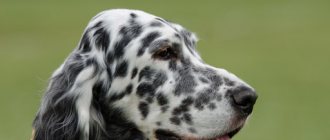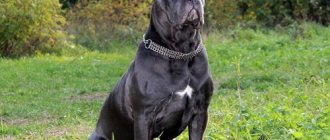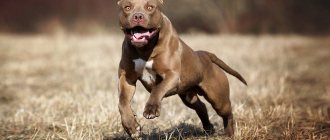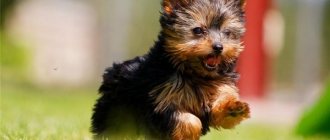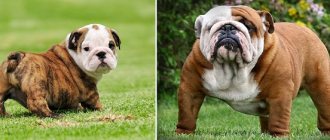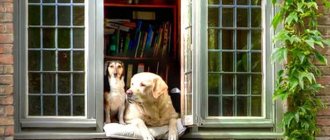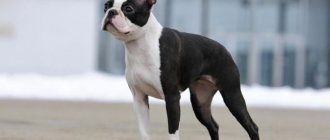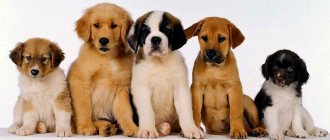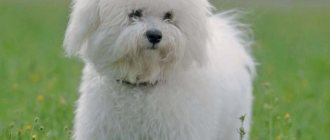Which dog should I buy for my child?
Having a four-legged family member has many advantages. Thanks to regular communication with animals, children quickly make new acquaintances and feel more relaxed in society.
The need for care also plays a significant role. Despite the fact that most of the responsibilities fall on the parents, kids can also feed, brush and walk their pet. This increases their discipline and sense of responsibility.
When choosing a new pet, it is important to consider the following factors:
- age of the future owner;
- footage of living space;
- size and sex of the animal;
- features of care;
- presence of an allergic reaction to wool.
Please note that the final decision must be made jointly. Only a teenager can completely delegate the care of a dog, but even here there will be some restrictions. For this reason, the puppy chosen must meet the wishes of all family members.
Age: infant, preschooler or teenager
When choosing a dog for a child, be guided by his age. Existing restrictions can be divided into 3 categories:
- Baby. Babies under one year old are unlikely to demand a pet from you. In this case, we are talking about your own desire. The safest option is large breeds that are good-natured and nanny dogs.
- Preschooler. If your preschooler is no more than 3 years old, then teaching him how to properly handle animals is quite problematic. At a later age, he can be explained how to communicate with a pet, and even assigned to some responsibilities. In the first case, focus on options for a baby, and in the second, on breeds that do not require complex care.
- Teenager. During adolescence, children are as independent as possible. If you are confident in your child’s responsibility, let him make his own choice. In this case, any dog listed below will do.
Please note that preschoolers should only interact with their pets in the presence of an adult. By carelessness, they can injure a small dog or accidentally get injured by a large four-legged animal during play.
For a country house or apartment
The best dog breeds for home and children are guard, herding and hunting dogs. The first will guard your site, the second will keep an eye on their little owners, and the third will be able to independently satisfy their need for activity.
An apartment imposes more restrictions. A small living space is not suitable for large and active dogs. Small dogs, as well as calm couch potato pets, are adapted to life in such conditions.
Pet size
The size of the animal affects not only the conditions of its keeping, but also its character. Small dogs are more capricious and jealous. They do not tolerate rough treatment and can bite a naughty owner without warning.
Large dogs are difficult to injure, so they are always more patient than small ones. The only caveat is the difficulty of walking. A large pet is a reliable guard, but not every adult is able to keep it on a leash, let alone children.
Easy to care and feed
A dog for a child should be as easy to care for as possible. Otherwise, almost all responsibilities will fall on you. It is recommended to avoid long-haired representatives and breeds with problem ears or eyes.
Separately, it is worth noting feeding. It is possible to explain to a child the dangers of feeding only at a conscious age, so you should not take a four-legged pet with allergies or a tendency to be overweight.
Male or female
We must not forget about gender. Males are more dominant and less flexible. They often get into fights and react very violently to bitches in heat. Because of this, it is problematic to walk with them unaccompanied by adults.
Bitches are more obedient and often perceive their small owners as their own puppies. Difficulties with walking arise only during heat, but this can be avoided by sterilization.
Despite gender differences, not all animals conform to them. There are always exceptions, so you should additionally focus on the character traits inherent in a particular breed. “Energizer dogs” are suitable for active kids, and phlegmatic dogs are suitable for calm kids.
Having an allergy to wool
A dog for a child with a hair allergy should either be hairless, rarely shed, or have a special hair structure. Please note that these features do not exclude the occurrence of a reaction to other allergens: saliva, urine, sweat, secretions of the sebaceous glands, dandruff and dead skin particles. For this reason, doctors recommend that allergy sufferers not buy pets with excessive salivation.
To be safe, try introducing your baby to the puppy before purchasing. If staying in the same room for 1-2 hours does not cause a negative reaction, then with a high probability it will not occur in the future.
Content
1. Border Collie 2. Sheltie 3. Australian Shepherd 4. Beagle 5. Dachshund 6. French Bulldog 7. Cocker Spaniel 8. Boston Terrier
Often people living in apartment buildings are faced with the question of choosing a pet for themselves. Having a large dog is not an option, and a small animal somehow does not correspond to one’s worldview. In this situation, a dog for a medium-sized apartment is optimal. Its weight varies from 15 to 25 kg.
Today, breeders offer a fairly large selection of a wide variety of breeds, each of which deserves close attention. It is important to approach the identification of your pet as carefully and responsibly as possible, since you are not purchasing a toy that you can then hide, but a living creature. And for it in the future you, as the owner, will bear full responsibility.
The kindest dog breeds for children
First of all, choose dog breeds that love children. They are distinguished by a good-natured disposition, easygoing nature, calm character and lack of aggression towards humans.
Retrievers
The most popular breeds for families are the Labrador Retriever and the Golden Retriever. Both four-legged animals were bred for hunting, but due to their extraordinary love for humans, most owners acquire them as companions. They are not suitable for protection, but they help cope with depression, charging them with optimism.
Sheltie (Shetland Sheepdog)
Shelties are incredibly loyal and have an inexhaustible supply of energy. They have a special love for playing with their owner, which is very important for building relationships with children. Shelties cannot stand loneliness, so a noisy company of children is a priority for them.
Bulldogs
The friendliest bulldogs are English and French. They love children's company, but are slightly different in character. “The English” are lazy and love to sleep, so they are ideal for calm children. The “French” are their opposite with an inexhaustible supply of energy.
Poodle
All varieties, including the smallest ones, are distinguished by their extraordinary intelligence and love for an active lifestyle. Poodles perceive human speech well, quickly learn new commands and are happy to be trained under the guidance of little ones.
Welsh Corgi
Both Pembrokes and Cardigans are famous for their kindness, but the former are most often kept as pets. Cardigans are more phlegmatic, but they also love to play around. Please note that corgis looking after their little owners may lightly bite them on the legs when they deviate from the desired trajectory. In this way, they demonstrate their shepherd instinct, protecting their owners like a herd of cows or sheep.
Border Collie
This dog ranks 1st among the smartest. Border collies quickly learn new skills and perfectly follow any commands. They have a special love for their owners and happily tinker with the little ones all day long.
Bernese Mountain Dog
A four-legged giant with an unusually charming smile reaches psychological maturity only by 2 years. At this age, his curiosity and carelessness are replaced by calmness and equanimity, but this does not at all prevent the mountain dog from participating in any outdoor games with the same zeal.
Newfoundland
This big guy is famous for his heroism and kindness. He loves to communicate with people and gets along well with any pets, including cats and birds. The Newfoundland is also very attached to its family and has a very difficult time being separated.
Setters
Irish and Scottish Setters are ultra-social and require very long, active walks. Up to 3 years of age they are hyperactive and love to play pranks. They cannot stand loneliness and gladly accept any affection, including strong hugs from babies.
Dalmatian
Without regular physical activity, the Dalmatian becomes uncontrollable, so it is recommended to keep it in a private home with the possibility of free walking. This pet is not suitable for children under 3 years of age. The Dalmatian may accidentally injure them during play, not calculating his weight, or instinctively attack due to congenital hearing problems. In the latter case, it is important to explain to the baby that you cannot approach the animal from the back or wake it up during sleep.
Basset Hound
Bassets are unusually sociable and cheerful, but this does not at all interfere with their love for the sofa lifestyle. They are not at all characterized by aggression, so in the event of a robbery it is better not to count on them.
Beagle
A cheerful and energetic good-natured fellow loves to frolic in the fresh air. Thanks to his love of games, he quickly becomes a friend to children. The Beagle easily finds a common language with other dogs, but it is better not to introduce it to cats, rats, hamsters and parrots due to its developed hunting instinct.
Cavalier King Charles Spaniel
A shaggy fidget with an unusually charming appearance is in a positive mood 24/7. Regardless of a person’s age, the Cavalier King Charles becomes very attached to him. Due to his lack of attention, he can cause some pretty serious damage to your home.
French Bulldog
The four-legged animals of this breed are intelligent and easy to train. But they are too impulsive, such choleric people. At any moment, even the most trained dog can throw some kind of surprise, play pranks, or get out of control. No, they don’t do anything serious, but they can make you worry.
The French Bulldog is immensely loyal to its owner and even jealous. Ideally, it is recommended to have this breed if there are no other animals in the apartment. He definitely won’t leave them alone - conflicts are inevitable. And this must be remembered before buying a puppy, without fail.
Small dog breeds for children and apartments
Small dogs are not suitable for all children. They are easily injured and often get sick, which is due to the fragility of the bones and the characteristics of any decorative breed. Despite this, small dogs are ideal for apartment conditions. They are easily litter trained and do not need long walks.
Yorkshire Terrier
Despite its modest size, the Yorkie is a typical terrier. He is energetic, resilient and very courageous. Due to its innate curiosity, the Yorkie is often distracted during walks, but never moves too far away from the owner, preferring to keep him in his field of vision.
Dachshund
Dachshunds are not suitable for melancholy owners, but they get along well with people who prefer an active lifestyle. These four-legged animals are known for their independence and stubbornness, so it is better to train them together with an adult.
Shih Tzu
Another great dog for children is the Shih Tzu. She is not cowardly, has good self-control and does not worry about trifles. The only thing that can throw her off balance is long-term loneliness.
Pekingese
Fluffy Pekingese are peaceful towards any pets, but they are more selective towards children. Due to the low pain threshold and love for a peaceful environment, they are suitable exclusively for teenagers and preschoolers who know how to restrain their emotions during hugs.
Miniature Schnauzer
These small four-legged animals cope well with the role of protector and hunter. Despite their rather serious nature, miniature schnauzers are very good-natured around the family. They show a particularly caring attitude towards children, with whom they can have a lot of fun while playing.
Pomeranian Spitz
Pomeranians become so attached to their owners that they prefer to share the same bed with them and even take a shower. Despite their friendliness, they are quite capable of standing up for themselves and do not accept cruel treatment at all. For this reason, Spitz, like Pugs, are more suitable for conscientious children.
Papillon
The Papillon is the only small dog for children to be included in the top ten smartest breeds. Despite his acute intolerance to loneliness, this four-legged animal never stoops to damaging furniture and constantly looks at the world through rose-colored glasses.
Pug
Pugs are friendly to all people, regardless of their age and the fact of their acquaintance. During games, it is important to take into account the weak feature of the breed - large and bulging eyes. They are easily injured and prone to falling out.
Australian Shepherd
This dog for a medium-sized apartment is not suitable for all people, so to speak, it’s not for everyone. It is important to understand that Australian Shepherds were bred to be used as herders. Two aspects arise from this. Firstly, she will constantly collect in one place various things placed throughout the apartment, for example, slippers, shoes, and you will not be able to do anything about it.
She also likes to bite people's legs, not much, but guests, for example, can be frightened by this action. Secondly, for walks you really need space so that the Australian Shepherd can run out to the fullest, that is, there must be a field, park, square, forest, and so on nearby. Otherwise, there is a high probability of developing joint diseases, arthrosis, and cardiovascular diseases.
What dog breeds are suitable for children with allergies?
Be sure to check out the list of four-legged friends for allergy sufferers. Although hypoallergenic, the breeds listed below have completely different personalities and sizes.
Basenji
The Basenji cannot bark, practically does not smell like a dog, and is famous for its cleanliness. Due to the lack of undercoat and low shedding, it is classified as conditionally hypoallergenic. That is, it can cause allergies, but much less often than other dogs.
Komondor (Hungarian Shepherd)
The corded coat of Komondors does not cause allergies and does not require complex care. These four-legged animals are extremely loyal to children, but only to acquaintances. They are suspicious of others due to their pastoral background.
Bolonki
Maltese (Maltese) and Bichon Frize (French) hardly shed and do not have a specific dog smell. Both dogs are famous for their mischief and energy. The main difference between these breeds is the extraordinary jealousy of Maltese dogs.
Chinese Crested
These four-legged animals are hairless and downy, but both are hypoallergenic. Chinese Cresteds idolize their owners and cannot stand being alone. Without regular communication, they go crazy and fill the whole house with a loud howl.
Italian Greyhound
The Italian Greyhound is an unusually gentle dog, reminiscent of a cat in its habits. She loves to rest on any horizontal elevations and hates water. Due to its low shedding and smooth coat, it is classified as conditionally hypoallergenic.
Samoyed
Like the long-haired Maltese, the Samoyed is notable for its luxurious snow-white coat. He rarely sheds, does not smell like a dog and is not prone to dandruff. Samoyed wool has water-repellent properties and a self-cleaning function. Thanks to this, it not only does not cause allergies, but also does not require complex care.
Nannies or security guards
Dogs that get along with children should definitely include four-legged nannies and guards. The former are distinguished by their extraordinary overprotection and tolerance, and the latter by their impressive strength, which allows them to protect the owner from any intruders.
Saint Bernard
Balanced and very good-natured, Saint Bernards are not without playfulness. They love to play pranks with babies and take on the role of nanny with great enthusiasm. Their only drawback is intense salivation.
Siberian Husky
Love for babies is in the husky's blood, so you can even trust him with a baby without fear. Despite his friendliness and excellent learning abilities, he is distinguished by his stubbornness and desire for leadership. Because of this, his training should only be done by an adult.
Collie (Scottish Sheepdog)
Collies are peaceful, patient, smart and courageous. Thanks to these features, they are often used as nannies, but they are not suitable as a bodyguard due to their innate lack of aggression towards humans.
Bobtail (Old English Sheepdog)
Bobtails are famous for their playful nature. They love to play pranks with the kids, but they also take the role of nanny very seriously. Because of this, during a walk, a strong impression is created that it is the dog who is walking the baby, and not vice versa.
English Mastiff
Despite its formidable appearance and good guard qualities, the mastiff is an example of calm and steadfastness. Due to its phlegmatic nature and large dimensions, it is not suitable for overly active children and infants. It is better to take such a dog for teenagers or for homebodies in elementary school.
German Shepherd
The most popular service dog is often purchased for the family. It's all about her devotion and complaisance. The shepherd dog unquestioningly recognizes the authority of the owner and can even be trained under the guidance of children.
Rottweiler
The Rottweiler is similar to the German Shepherd in many ways. He is also one of the TOP 10 smartest four-legged animals, is endlessly devoted to his owner and is famous for his protective qualities. The only thing that distinguishes them is a greater distrust of strangers. Rottweilers are very patient with the kids in their family, but they see everyone else as a potential threat. For this reason, these animals need very competent upbringing.
Doberman
Another example of an ideal and obedient protector is the Doberman. With timely socialization, he becomes a full-fledged family pet, and not at all a “fiend of hell.” Thanks to its independence, the dog is perfectly oriented in the situation and, without additional commands, distinguishes between the time for pranks with the children and their protection.
Moscow watchdog
The Moscow Watchdog is the result of mating a St. Bernard and a Caucasian Shepherd, so its character combines a favorable attitude towards children and a developed protective instinct. Due to its large size, it is better to keep such a pet in a private home.
German dog
Great Danes are ideal protectors and bodyguards. Due to their phlegmatic nature, they can even live in an apartment, but only if there is sufficient space. The only disadvantage of these noble four-legged animals is their poor health and short life expectancy.
Staffordshire Bull Terrier
Because of their past, Staffords often receive accusations of wanton aggression. In fact, the opinion about the viciousness of this breed is wrong. Modern Staffords are the kindest, human-oriented creatures. Unlike the Rottweiler, they are with great pleasure ready to provide their belly to any baby they meet.
Alabai
Fearless Alabai were bred for protection, so distrust of strangers is in their blood. Despite this, they do not see any danger in the kids at all. Alabai are always welcoming to them.
East European Shepherd
The East European Shepherd is the closest relative of the German Shepherd. It is endowed with a similar character, but more modest dimensions. It is also worth noting less temper, which is very important when dealing with little pranksters.
Irish Wolfhound
The cruelty of Irish wolfhounds only manifests itself during the hunt. Among the family, these four-legged animals are completely harmless. They are indulgent towards their little owners and, up to 2 years old, support any of their fun with puppyish enthusiasm.
Schnauzers
This should include the Giant Schnauzer and its closest relative, the Black Russian Terrier. The first representative is as restless as children, so first of all he makes friends with his little owners. The Black Russian Terrier is calmer, but this does not prevent him from taking an active part in children's games and even some pranks.
Boxer
Playful and energetic boxers do not choose their favorites and become attached to all family members without exception. Thanks to their good security qualities, they can be entrusted not only with the role of a friend, but also with a bodyguard.
Jack Russell Terrier
The most popular terrier for children is the Jack Russell. This is a typical “energizer”, ready to play with its owners for days on end. It is important to understand that the terrier did not tolerate it. You can't treat him like a teddy bear. Otherwise, you may get a “bite” response.
Cocker Spaniel
American dog breeds take root well in our apartments. They are quite friendly and have a neutral attitude towards outsiders, which can be very important for those owners who love noisy and large companies. Firstly, the dog will not bother or stress them, and secondly, the animal itself will not experience stress, which is inevitable for representatives of other breeds.
Such a pet is suitable for people who are self-confident and self-sufficient. But it is not advisable to have very young children in the family. Sometimes American Cocker Spaniels show jealousy. The same goes for other animals in the apartment. In general, similar characteristics can be noted in Russian Cocker Spaniels.
Should you adopt a mongrel or animal from a shelter?
Adopting a mongrel or an animal from a shelter is a very noble deed, but it is better to take a dog for a child only from trusted kennels. The character of mestizos is not predictable, and an abandoned purebred pet needs special attention and long adaptation.
In both cases there is a high risk of aggression or cowardice. An animal with an unhealthy psyche is difficult to train and often attacks its owners, so it is better to avoid such increased danger.
Do you like the article? 0
Bull type terriers
Crosses of bulldogs and terriers were bred in Great Britain throughout the 17th and 18th centuries specifically for baiting animals - the national pastime of the British. Outwardly inconspicuous bull and terriers have absorbed the best fighting qualities. Hunting terriers have inherited agility, speed, passion, and flexibility. From bulldogs they adopted tenacity, a “death grip”, and immunity to pain.
Four breeds became direct descendants of bull and terriers. Aggression is regarded as a serious defect; evil individuals are simply excluded from breeding.
English bull terrier
English bull terriers mini and standard.
In addition to fighting bulldogs, the now lost white English terriers and Dalmatians took part in the selection. Initially, only white bull terriers were recognized. In the 20th century, colored individuals were introduced into breeding.
The breed includes a miniature group of dogs. The height of a standard bull terrier is up to 51 cm, a mini one is up to 35.5 cm.
English Staffordshire Bull Terrier
The smallest representative of the bull type terrier. Height at the withers is 35 - 40 cm. Education and selective selection have turned fighting dogs into lovely home companions.
American Staffordshire Terrier or Amstaff
The first name of the breed is pit bull terrier, from the word “pit” - pit for baiting. In 1936, a separate AKC standard was drawn up for Amstaffs and recognized as an independent breed.
Amstaffs are larger than their English relatives, height at the withers is 43 – 48 cm.
The first registered representative of the breed was the American Staffordshire Terrier named Pete. In the 30s, he starred in gangster comedies and was considered a real star.
Initially, the Amstaffs' element was dog fighting. Now they are companions and show dogs. Owners call their pets good-natured hulks at home and brave defenders on the street.
American Pit Bull Terrier
Pit bull terriers are similar in appearance to Amstaffs, but are more diverse. The breed includes bulldog and terrier type dogs.
American Pit Bull Terriers are banned in many countries around the world. Scary stories are told about the unpredictability and viciousness of dogs. However, many owners emphasize the restraint and good nature of their pets and insist that the character of dogs depends on their upbringing.
The height of pit bulls is from 40 to 60 cm, but there are real giants. The world's largest pit bull terrier, Hulk, weighs 80 kg.
The breed is recognized by the only cynological organization - UKC. The founder and president of the club, Chauncey Bennett, registered his own pit bull terrier under No. 1 in 1898.
